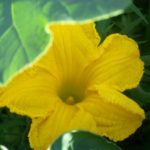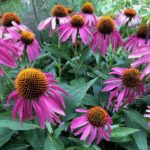New Moon Greetings – May 19, 2023
Garden Evolution

Garden Experiments are about pushing the boundaries of what you ordinarily grow. When my children were young, I focused my garden efforts exclusively on edible plants and healing herbs. Feeding people and having plants to make my own teas, tinctures, and salves was the top priority. My garden included the usual vegetables like tomatoes, peppers, beans, and zucchini, along with basil, oregano, lemon balm, and calendula.

My household now consists of just me and my four-legged companions, Luna and Millie. Because I have the space, my gardening has evolved to include all kinds of non-edibles that I think are beautiful and interesting. I might have a projected use for them, but if the project or plant does not pan out the way I imagined, it is okay. It is not cutting into the food harvest.
Garden experiments can be as simple as trying a new variety you’ve never grown before or using a plant in a new way. Many plants can be used for dyes, paper-making, fiber, or other art projects. Another way to experiment is by pushing the limits of what can be grown in your climate. So what follows are just a few of my garden experiments for this season.
Garden Experiments for 2023

Over the last few years, I have been intrigued by growing, harvesting, and spinning flax , as I’ve written about in this blog. Flax is a bast fiber, which means it comes from the inner bark of the plant. And I’ve discovered that there are other plants in my garden that can be spun using their bast fibers. These include stinging nettles, hops, and butterfly weed.
One of my garden experiments is to harvest, clean, and spin at least a small quantity of each one this year. The process for releasing the fibers from the plants is the same as flax. So it is a little labor intensive, but very much worth it. Having enough time to pull this off is the only thing standing between me and achieving my goal. I will let you know how it goes!

Adding a New Fiber Plant – Ramie
I’ve also found a new bast fiber plant – Ramie (Boehmeria nivea, pronounced ray-me). Ramie is another ancient plant that has been used to spin fabric for at least 6,000 years.
It is in the same family as stinging nettle and is sometimes called Chinese nettle, but it has no sting. It also differs from stinging nettle in that it won’t overwinter here in Denver’s cold. My plan (if it grows) is to either take cuttings inside for the winter or bring the whole plant indoors in a pot. The plant is propagated through rhizomes so those could possibly overwinter in my house as well.
I don’t know anyone else growing ramie and I’m not sure how successful I’ll be but that’s the fun of it. I have tiny seedlings coming up right now (too tiny to even post a photo) and I will keep you updated on my progress with this one.

White Sage from Seed
Another hopeful addition to my garden is white sage (Salvia apiana). You may be familiar with white sage as an herb that is sacred to many Native Americans cultures. It is used in ceremonies to cleanse and purify an area. Leaves contain eucalyptol, a plant chemical that creates the cleansing fragrance.
The plant is becoming endangered because of over-harvesting in the wild. Once I learned this I decided to track down seeds and attempt to grow my own.
White sage is related to garden sage (Salvia officinalis), but they are different plants. Salvia apiana is native to Southern California and prefers dessert-like conditions. It should be pretty comfortable in Denver’s hot and dry summers, but, like ramie, it probably won’t survive the winter outdoors. Also like ramie, I could try moving the plant indoors for the winter.
However there are many perennial plants that we grow as annuals because they can’t live through the winter. Tomatoes, eggplants and peppers are in this group. So it is possible that white sage and ramie could be grown this way. What I don’t yet know is if there will be enough growth in one season to be able to harvest some of the plants. That’s why it is an experiment!

Just a note – I was able to find both Ramie and White Sage seeds at Trade Winds Fruit in California, if you are interested in trying your hand with either plant.
Garden Experiments – Inventing Your Own
Garden experiments are about pushing the limits on what you grow in your garden, exploring new plants and new ways to use plants. It is much easier to find interesting heirlooms and unique varieties at garden centers and in catalogs than it used to be. (See the Baker Creek Rare Seeds website for ideas.) Gardening is of course a joy all on its own, but it increases the joy factor when we invite unique and interesting plants into the garden.
If you have some garden experiments happening this year I would love to hear about them in the comments. And I will keep you posted about mine.
Lunar Blog Post Series

This post is part of my lunar blog series. Each full moon I write about one plant, many of them are plants featured in my book, Growing Mindful. Each new moon I write about a topic related to gardens, mindfulness, and spirituality. For more details and a list of past lunar blog posts, click here.




Ramie has a beautiful hand. Had some shirts years ago. Fabric feels so silky on the skin. Always wondered where it came from…pre-google. lovely to know.
Susan, Yes! I got some Ramie fiber on Etsy and have been spinning it and it is very silky. That’s when I decided I need to try to grow it!